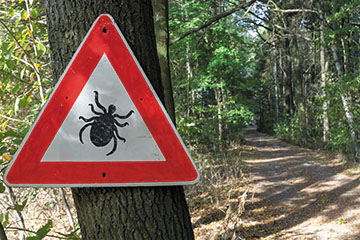14
Jan
New Method of Lyme Disease Prevention Promising, But Not Ready to Replace Personal Protective Measures

tick insect warning sign in forest
(Beyond Pesticides, January 14, 2020) Scientists have found a new method to reduce the sources of Lyme disease, but it is uncertain whether the finding will ultimately translate into fewer cases of human infections. Research published in the journal Experimental and Applied Acarology finds that incorporating Lyme vaccines into pelletized mouse food had the effect of reducing levels of Borrelia burgdorferi, the bacterium that causes Lyme disease, in both mice and ticks in a certain location.
“So, the idea here is to vaccinate the mice,” study author Kirby Stafford, PhD told WBUR. “What we’ve done is incorporate a Lyme disease vaccine in an oral bait that would immunize them. That would prevent ticks feeding on those animals from becoming infected and then ultimately turn around and infect you.”
To test their approach, researchers enrolled 32 homes in Redding, CT, an area where Lyme disease in endemic and several human cases are reported each year. Vaccine-incorporated mouse baiting stations were placed around 21 homes, while 11 acted as a control. Four times throughout the two year study period, mice and the ticks attached to them were trapped and tested for the disease. While there were no significant differences between the experimental and control plot in the first year, this changed after the second year of study.
In areas where the vaccine bait was placed, mice infections were significantly lower than controls, with tick populations following suit. Only 9% of ticks were found to be infected with Borrelia burgdorferi in treated areas, while ticks at control plots displayed a 39% infection rate.
While the study shows promise for a novel method of tick control, there is not yet enough data to say that the reductions will translate to protections for humans, according to a Bard College researcher interviewed by WBUR. “We’ve got nothing… nothing that’s been demonstrated to reduce the number of Lyme disease cases in humans,” said Felicia Keesing, PhD, a disease ecologist. “We have a variety of things that reduce the number of ticks in people’s yards. Those have not translated to having an effect on people’s health. So this study has the right idea, but it doesn’t mean it will necessarily translate into actually fewer cases in people.”
Past research has found that the use of toxic insecticides on suburban lawns can reduce the number of ticks in one’s yard. However, households whose lawns were treated with insecticides still reported a similar number of tick encounters and tick-borne illnesses as those whose properties were left untreated. Thus pesticides should not be considered a viable means of addressing Lyme disease transmission –particularly in light of the risks associated with of exposing one’s self and family to neurotoxic pesticides.
More recent studies focusing on highly toxic permethrin, which can be incorporated or sprayed onto clothing, have likewise been inaccurately reported in the media as a means of successful tick management. While simple repellents like oil of lemon eucalyptus, picaridin, and insect repellent IR 3535 can be effective in deterring ticks from finding and attaching to humans, DEET and permethrin should be avoided.
The best method to prevent tick bites and the diseases they carry is to wear appropriate clothing (light colored that covers one’s whole body), a hat, and consider tucking one’s pant’s into your socks. Most important is to conduct regular tick checks alongside a friend, as it’s critically important to detach a tick from one’s skin as soon as possible after the bite to reduce the chance of disease transfer. If you have an outdoor pet, don’t forget to check them as well (consider a flea/tick comb and remember areas like behind the ears and in between toes). For more information on how to manage ticks safely, see Beyond Pesticides ManageSafe webpage.
All unattributed positions and opinions in this piece are those of Beyond Pesticides.
Source: WBUR, Experimental and Applied Acarology










